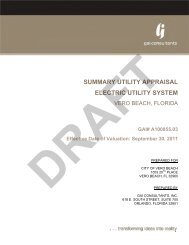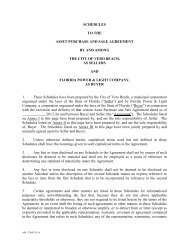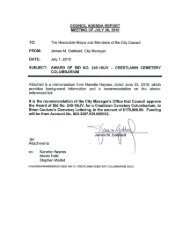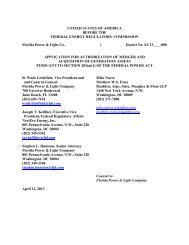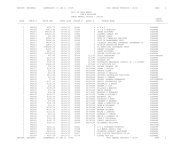sr 60 “twin pairs” - City of Vero Beach
sr 60 “twin pairs” - City of Vero Beach
sr 60 “twin pairs” - City of Vero Beach
Create successful ePaper yourself
Turn your PDF publications into a flip-book with our unique Google optimized e-Paper software.
TRAFFIC VOLUME FORECASTS<br />
To determine if the proposed cross-section would accommodate future volumes and to determine the<br />
impacts to other roadways and intersections in the study area, we projected traffic data to reflect the 2035<br />
conditions. The 2035 conditions correspond to the horizon year used in the latest Indian River County<br />
Long Range Transportation Plan (LRTP). The Greater Treasure Coast Regional Planning Model<br />
(GTCRPM) was utilized to forecast future volumes. The following model scenarios were used in this<br />
analysis:<br />
2005 baseline model<br />
2035 model, which reflects the traffic and roadway conditions based on anticipated demographic<br />
conditions and roadway network improvements identified in the 2035 LRTP (referred to as the “no<br />
build conditions”).<br />
2035 model modified to reflect the reduction <strong>of</strong> lanes on the SR <strong>60</strong> “Twin Pairs” (referred to as the<br />
“build conditions”).<br />
Model Calibration<br />
The roadway network coding was reviewed to ensure the characteristics <strong>of</strong> the roadway network within<br />
the study area are accurately reflected in the GTCRPM. This review included an assessment <strong>of</strong> traffic<br />
analysis zones (TAZs) centroid connectors, laneage, speed, facility type, and projected volumes. Where<br />
necessary, adjustments were made to the model network attributes, including modification <strong>of</strong> centroid<br />
connectors. The network adjustments were made iteratively until the model network and volumes were<br />
deemed to reflect actual roadway network conditions. The GTCRPM model output files are included in<br />
Appendix C.<br />
Growth Rate<br />
We calculated growth rates by comparing the traffic volumes forecast in the 2005 GTCRPM and 2035<br />
GTCRMP (no-build and build models). The purpose <strong>of</strong> estimating these growth rates was to establish<br />
future year (2035) traffic volumes with and without the SR <strong>60</strong> “Twin Pairs” lane reduction. A summary <strong>of</strong><br />
model-based traffic volumes that were used to develop growth rates is included in Table 5. Based on the<br />
review <strong>of</strong> traffic volumes, separate aggregate growth rates were applied for SR <strong>60</strong>, 21 st Street, and the<br />
north-south minor streets within the study area. These growth rates were applied to the existing traffic<br />
volumes to determine future year 2035 traffic volumes for the study area roadway segments and<br />
intersections.<br />
SR <strong>60</strong> “Twin Pairs” Traffic Calming Feasibility Study Page 12



